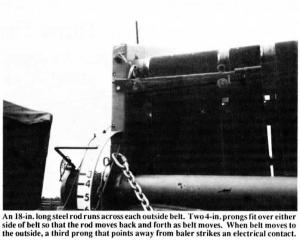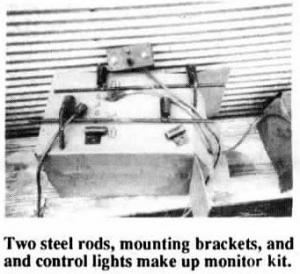1989 - Volume #13, Issue #5, Page #03
[ Sample Stories From This Issue | List of All Stories In This Issue | Print this story
| Read this issue]
Baler Monitor Helps Make Better Round Bales
 |
 |
Crick attached "sensors" to the outside belts and mounts a monitor in the tractor cab. A green light goes on when either side of the baler needs more hay. A light goes on when the baler is full.
"It doesn't show me anything that I can't see by turning around, but it saves a lot of wear and tear on my neck," says Crick, a commercial hay grower who built the monitor five years ago. "I got tired of constantly looking behind. When I did turn around I sometimes drove over the wind-row, which resulted in unevenly-shaped bales. Now that my bales are uniform, they stack more neatly on my truck. They're also easier to move with the grapple fork on my loader, which I use to move two bales at a time. If one bale is smaller than the other it's likely to fall off."
Crick says his monitor actually works better than commercial models that cost hundreds of dollars. "They monitor belt tension instead of tracking back and forth with the belts like this monitor. They can tell you if the bale's sides are evenly-shaped, but they can't tell you if the bale is high in the middle. My monitor picks up any belt movement so I know when and where to move the baler before any problems crop up. It takes about an hour to install."
The monitor consists of a pair of 18-in. long steel rods that run across each outside belt. Each rod is fitted with two 4-in. prongs welded to it at right angles. The prongs are spaced to fit over either side of the belt so that as the belt moves back and forth, the prongs move the rod, which is held loosely by its mounting brackets. A third 8-in. long prong mounts at the outside end of each rod, pointing away from the baler. When the belt and rod moves toward the outside, indicating that side of the bale needs more hay, the 8-in. prong contacts a bare galvanized 6-in. length of wire. The contact completes a circuit and causes one of two green lights on the monitor in the cab to flash, indicating that the baler needs to be moved either left or right.
The monitor simply wires up to the tractor battery. Crick used an "experimenter" that he bought from Radio Shack for $1.99 and drilled holes in it for the lights, which cost $1.89 each, and a switch. He attached one end of a standard 3-wire, 16-gauge, 25-ft. long extension cord to the monitor and the other end to the 6-in. long contact wire on the baler. A 3-prong connecter allows Crick to unplug the extension cord near the tractor drawbar.
The monitor works on any round baler that produces solid core bales, including Vermeer F, G, and H models.
Contact: FARM SHOW Followup, Dan Crick, Menno, S. Dak. 57045 (ph 605 387-5460).

Click here to download page story appeared in.

Click here to read entire issue
To read the rest of this story, download this issue below or click here to register with your account number.




